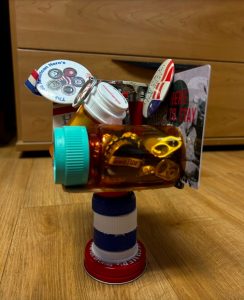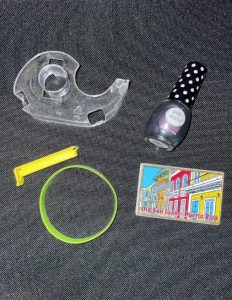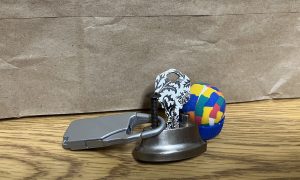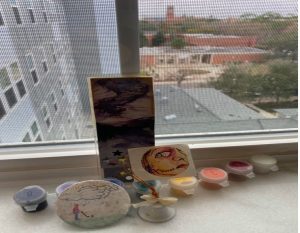Teaching with Trash: American Poetry & Personal Trash Piles
What impressions does a pile of discarded items reveal about your community? How might one or more of these items tell a story about a person (real or imagined)? How does arranging and photographing 5 items of trash highlight their aesthetic dimensions?
These are the questions I gave my undergraduate students for my most outlier assignment yet: Personal Trash Pile Brainstorming. I was looking for something hands-on for this semester’s course Modern American Poetry: Cities. I wanted to get these Gen Z students out in our Gainesville community now that they’d left their Zoom squares and returned to campus spaces. I wanted to engage them through our mutual interest in sustainability–including sustainable Humanities. And I wanted to find a more tactile means of attuning students to the details and dynamics of poems. After all, Wallace Stevens wrote a poem called The Man on the Dump.
I had a hunch that thinking about trash would push students to think more about the language in poems, the diction. Just think of the word hoard: debris, detritus, dregs, garbage, litter, refuse, rubbish, scrap, waste, and yes, trash. The garbage can really pile up in American city poems. I also had a hunch that making and reflecting on Personal Trash Piles would give students a keener eye for the experimental city films we were watching. How might arranging garbage attune students to the art of assemblage on the page and screen?
I brainstormed this assignment with Paige Glotzer at The Repurpose Project, Gainesville’s creative reuse center. An urban historian, Professor Glotzer was also putting the final touches on Spring classes. We like to talk about cities, we like to brainstorm, and turns out we like to talk trash. I’ve collaborated with Repurpose Project before, so I knew where the trashiest trash resided–in the Candy Shoppe where most items were plastic and would have gone to the landfill. I gave each student $2.00 to purchase 5 different items from this part of the building, and these instructions:
- Arrange your 5 items as a personal trash pile.
- Photograph your trash pile.
- Write 75-100 words each on the 3 brainstorming prompts at the beginning of this post.
- Submit your photo and brainstorming.
Parsing their adopted community through collective trash piles at Repurpose Project (and creating their own), the class perceived Gainesville as collegiate and sporty, as a synergy of work and play, as a home for artists and creative thinkers where imaginations run wild, as Madison Engler put it. The accumulated medical items in the city’s trash also reflected sustained illnesses, addiction, and other difficulties. In the thumbnails of stories the trash could tell, a mother bakes snacks for her kids’ sports teams. A child returns from school, proudly handing a parent the artwork they made in class. Someone cleans out a departed family member’s house and finds their childhood board games, discarding those with missing pieces. A graduating student sorts through memorabilia of their collegiate years, unable to take it all with them. Brainstorming with trash, students’ writing merged analytical, creative, and philosophical writing in varied and unpredictable ways.
As I’d hoped, the Personal Trash Pile Brainstorming Exercise also invigorated students’ writing for the Close Reading Paper on a contemporary poem that featured trash. In fact, we reinvented the close reading paper. And we’ve developed our own concept of the personal trash pile to complement perspectives on urban spaces and city walking that we’ve learned from Michel de Certeau, Gaston Bachelard, Anne Friedberg, Laura Elkin, and Louis Kahn. But I’ll write about that another time. -MB
SOURCES
All student images and quotations used by permission.





Comments are currently closed.